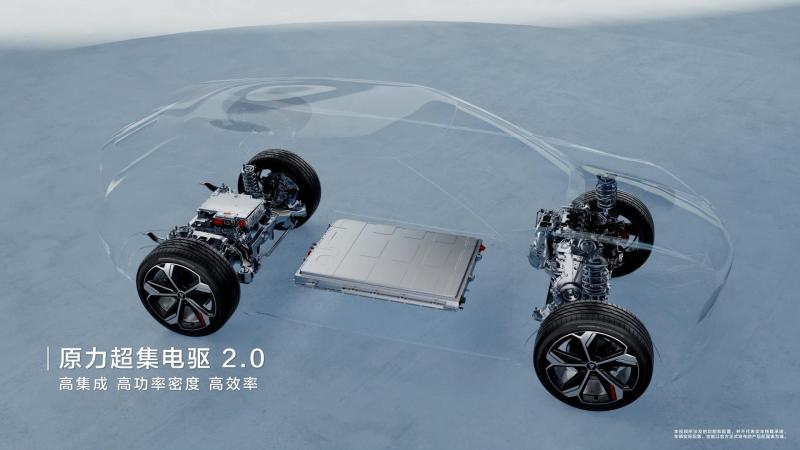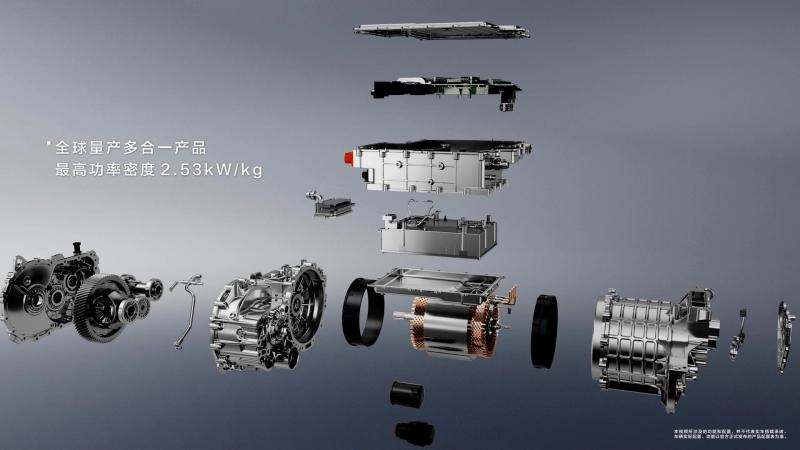Technical Unveiling: What Exactly is DEEPAL Super Extended 2.0 Technology?
 Kevin WongMar 28, 2024, 05:51 PM
Kevin WongMar 28, 2024, 05:51 PM
Changan DEEPAL currently offers two models in the Thai market, namely the DEEPAL L07 and DEEPAL S07. At this year's Bangkok Motor Show, both models introduced variants with different ranges, all featuring 100% electric drive. In the Chinese market, DEEPAL also offers these two electric vehicles. However, recently, DEEPAL launched its third model in China, named the DEEPAL G318, an extended-range off-road SUV. The name "G318" is derived from a highway in China, known for its scenic beauty and challenging high-altitude conditions, favored by off-road enthusiasts.
As it is a recent launch, DEEPAL did not showcase the G318 at this year's Bangkok Motor Show. Currently, there is no confirmation whether this model will enter the Thai market or when it might do so. However, a significant highlight of this vehicle is its use of an extended-range power system, referred to by the manufacturer as the Super Range 2.0 technology. From the name, it's apparent that this system is not entirely new but rather an upgraded version of an earlier system. This indicates that DEEPAL aims not only to produce electric vehicles but also to focus on extended-range models. For those interested in technology, let's delve into what makes this extended-range system special through this article. 
Explanation of DEEPAL Super Range Extension 2.0 Technology
The Super Range Extension 2.0 equipped by DEEPAL G318 includes three parts, namely the electric drive assembly, range-extended engine and generator system, and Golden Shield battery, all upgraded to the 2.0 version, so what areas have been upgraded specifically? How much performance improvement? Let's look at each one below.
1. Ultra-integrated Electric Drive 2.0
Firstly, let's talk about the electric drive, which directly impacts the vehicle's power output and energy consumption. The official data shows that the operating efficiency of the electric drive assembly reaches 92.59%. It's worth noting that this efficiency figure refers to the entire electric drive assembly, not just the motor, which demonstrates a commendable level of efficiency. How is this achieved specifically?
The official data includes improvements in efficiency through various technologies: adoption of SIC Mosfet for a 1.7% efficiency increase, magnetic steel sheet insulation for a 0.7% increase, globally thinnest ultra-thin low-loss stator silicon steel sheet at 0.2mm for a 0.5% increase, adaptive lubricant level control for a 0.2% increase, and optimized oil passage topology design for a 0.1% increase. These enhancements demonstrate the meticulous optimization required to improve the efficiency of the electric powertrain.
In addition to efficiency, this generation of electric powertrains has also seen reductions in weight and volume. Specifically, the weight of the electric powertrain has decreased by 17%, while the volume has decreased by 10%. The optimization of the electric control unit (ECU) has seen the most significant improvement, with a weight reduction of 23.8% and a volume reduction of 32.4%. Measures undertaken include modular integration of the ECU, integrated cooling water and oil channels, integrated suspension, three-stage three-axis bearing integration, integrated encapsulation of thin film capacitors and filtering devices, direct connection of drive control layer PINs, and modular partitioning with staggered stacking for low Z configuration.
So, compared to competitors, how much has been improved? Converted into total success rate density, according to the data given by the official, DEEPAL's 2.53kW/kg total success rate density is superior to HUAWEI, Tesla, and Xiaomi. Good performance in this data brings benefits such as occupying smaller in-car space and lighter weight also helps to reduce energy consumption performance.
The official also mentioned that the original super-electric drive is still evolving. The next generation of electric drives can achieve a total success rate density of 3.2kW/kg, and the working condition efficiency of electric drives can also reach 94%.
2、Original intelligent range extender 2.0
Let's look at a set of data first. This range extender system can achieve 1L oil to generate 3.63 degrees of electricity, and the official claims that this is currently the highest oil-electric conversion efficiency in the mass production range extender system. What does oil-electric conversion efficiency mean? This is easy to understand, it means generating the most electricity with the least oil so that you can travel a longer distance. It is more fuel-efficient. So how is it achieved? It is mainly divided into two parts: a new blue whale engine and a range extender dedicated generator system.
Firstly, the range extender uses the new Blue Whale engine, i.e., a 1.5T dedicated engine, with a rated power of 110kW, a maximum torque of 220N·m, and a thermal efficiency of up to 44.28%. In addition, a series of upgrades were made in technology, including high-pressure direct injection, high-energy ignition, high bore-to-stroke ratio, and ultra-low friction.
For example, in terms of high-pressure direct injection, it adopts a 500bar ultra-high pressure fuel injection system, it is known that the industry generally operates at 350bar. What benefits can higher fuel injection pressure bring? The atomization effect of the fuel will be better, which can achieve an average spray droplet size of 6.3 microns. At the same time, a 150mJ high-energy ignition system and a 16:1 ultra-high compression ratio are used. Therefore, the gasoline combustion in the cylinder is more sufficient; power is higher; emissions are cleaner, and fuel consumption is lower.
To improve the thermal efficiency of the engine, reducing internal friction is also an important part. For this reason, the engine also carried out a series of optimizations, such as microscopic variable groove narrow bearing, carbon nanocoating piston rings, asymmetric friction-reducing pistons, mirror polishing crankshafts, etc. In addition, PCJ technology with electronic control dual injection pipes is adopted to cool on demand, reduce friction, and at the same time, reduce the power consumption of the oil pump.
For the generator part, a range-extending dedicated oil-cooled generator system is adopted. It is equipped with a dual motor module, with a peak power of 100kW and a continuous output power of 70kW. To continuously maintain high power output, good cooling ability is essential. The uniquely created auxiliary motor cooling system uses electromagnetic control separately for targeted cooling, which provides better cooling effects. The official statement is that it can achieve a cruising speed of 180km/h when the battery is running low, with or without electricity, it's all seamless.
3. Golden Shield Battery 2.0
The main features of the Golden Bell Cover Battery 2.0 are four aspects, in official words, long life, true safety, super high efficiency, and fast energy supplement.
Firstly, in terms of battery life, optimization was carried out at the level of the battery cell, such as adopting multi-function coating and electrolyte film modification. On the other hand, the stability of the material is improved, and the increase in cyclic internal resistance can be further reduced. Specifically, it can achieve a cycle life of more than 5000cls, and a driving distance of 600,000 kilometers without noticeable decay.
In terms of safety, at the level of the battery cell, a high safety design has been applied, such as nano-fiber separator technology, which increases the heat resistance from 150°C to 200°C. The high-stability single crystal blending technology can increase the thermal stability by 12%.
In terms of active safety monitoring, the Vehicle · Cloud AI machine learning intelligent diagnostic algorithm group is used, with the battery safety warning accuracy rate approaching 100%. In terms of passive safety, through the combination of dredging and blocking technology, it achieves zero thermal runaway of the battery, including full-time temperature alarm technology, directional pressure sensing exhaust heat technology, alcohol cooling efficient heat dissipation technology, transient pressure relief technology, self-fusing isolation technology, full-domain short circuit protection technology, etc.
In terms of the battery pack, it has also been upgraded to CTP/CTV 2.0, and uses AHSS high-strength steel integrated tray technology, honeycomb aluminum protection technology, ultrahigh pressure sealing design technology, etc. The entire battery pack has a maximum integration efficiency of 86%, the volume utilization rate is increased by 2.9%, and the Z-directional space of the battery pack is reduced by 11.9mm.
In terms of energy replenishment, starting from 2024, DEEPAL super-range extension will be orderly upgraded to 3C charging (30%~80%SOC charging duration 15min). To increase the charging speed, ion channel acceleration technology is used, which mainly improves the lithium-ion transmission speed from the perspectives of shortening the ion transmission path, fast charge electrolyte, and multi-layer gradient coating.
In addition, to improve the charging efficiency in cold weather, the battery pack also uses the Creative Wide Temperature Region Micro Nuclear High Frequency Pulse Heating Technology, so that in severe cold weather can quickly heat the battery to allow the battery to reach the optimal working state, thereby reducing the battery cold attenuation, longer range.
If any infringement occurs, please contact us for deletion

Tesla pushes 2025.2.6 update in North America, activating the hidden millimeter-wave radar in Model Y
[PCauto] In February 2025, Tesla rolled out the 2025.2.6 software update for 2022 and subsequent Model Y models in North America.The highlight of this update is the activation of the hidden millimeter-wave radar hardware in the Model Y cockpit. This AWR6843 chip supplied by Texas Instruments, has three transmitting antennas and four receiving antennas, operating on a frequency band between 60-64 GHz, with a horizontal field of view of 120 degrees and a vertical field of view of 60 degrees.Once a

BYD Plans to Promote 1000V High Voltage Super Charging Stations and Its Models on a Large Scale
【PCauto】Recently, the news that BYD plans to massively implement a 1000V high-voltage supercharging platform has attracted widespread attention. It is reported that this platform will be launched in the middle of March this year and supports super-fast charging above 5C. After its release, it will quickly be popularized to its own models and large-scale construction of 1000V supercharging stations.This move will undoubtedly set off a wave in the new energy vehicle market. Let's delve into the te

XPENG G9 is about to be launched in China, bringing 66 upgrades in features
【PCauto】XPENG has recently announced that the 2025 XPENG G9 will soon be launched in China. Although the official did not announce the time and price, the success of XPENG G6 and X9 has rekindled expectations for the once-failed G9 by XPENG. In terms of appearance, the G9 continues the X-BOT FACE 3.0 design language, with a closed grill at the front paired with split-style headlights on both sides, new two-tone collision colors and all-black body styles, with a petal-style wheel hub. Combining

Hyundai is to launch an all-solid-state EV battery production line, but who's leading?
【PCauto】News reveals that Hyundai will launch an all-solid-state EV battery production line next month, with a ceremony to be held at the next-generation battery research center in Uiwang, South Korea.This production line will serve as a pilot production for the all-solid-state 'Dream' EV battery. In 2023, Hyundai proposed plans to become a leader in the electric vehicle battery field, investing over $9 billion in the battery sector within 10 years, including Lithium Iron Phosphate (LFP) and Lit

Tesla's Texas factory was caught testing vehicles, suspected to be Model Q
【PCauto】Recently, a blogger captured a disguised Tesla test vehicle while filming a drone over Tesla's Texas super factory. This discovery has sparked widespread speculation, as the new Model Y has been openly pre-ordered and there is no need to disguise, so it is speculated that this car may be the cheapest model Model 2 or Model Q (internal code name Project Redwood) that Tesla plans to launch.Speaking of this mysterious Model Q, Musk has already revealed that it will be a "smaller" version of
Popular Cars
Car Compare









